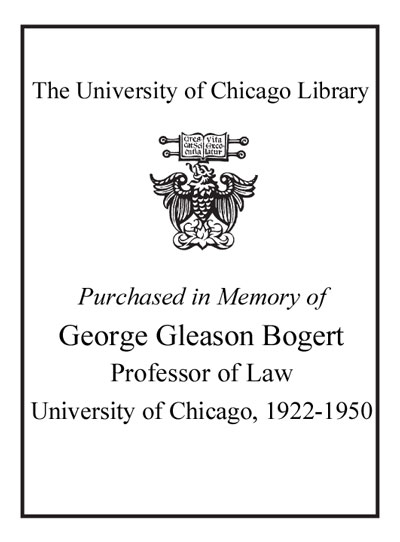Landlord and tenant law in context /
Saved in:
| Author / Creator: | Bright, Susan. |
|---|---|
| Edition: | New ed. |
| Imprint: | Oxford ; Portland, OR : Hart Pub., 2007. |
| Description: | lxxiv, 816 p. ; 24 cm. |
| Language: | English |
| Subject: | |
| Format: | Print Book |
| URL for this record: | http://pi.lib.uchicago.edu/1001/cat/bib/6653222 |
Table of Contents:
- Part 1. Introducing the Relationship
- 1. Introduction to Landlord and Tenant Law
- 1.1. Understanding Leases in Context
- 1.2. The Language of Leases
- 1.3. The Variety of Letting Arrangements
- 1.4. Key Issues and Trends in the Different Sectors
- 1.5. Explaining the Structure of the Book
- 1.6. Some more Terminology on Leases
- 2. Keys to Understanding Leases
- 2.1. Introduction
- 2.2. Leases in a Map of the Law
- 2.3. The Hybrid Nature of Leases: Part Property, Part Contract
- 2.4. The Private Law Relationship and the Common Law
- 2.5. Landlord and Tenant Law as Regulatory Law
- 2.6. The Public Law Dimension
- 2.7. Leases and Land
- 2.8. Leases as Split-ownership
- 2.9. Intervention in the Landlord and Tenant Relationship
- 2.10. Interpretation of Leases and Leasehold Notices
- Part 2. Entering the Relationship
- 3. Identifying Leasehold Relationships
- 3.1. The Essential Elements of a Lease
- 3.2. Different Categories of Occupation
- 3.3. Categorising a Relationship
- 4. Entering the Tenancy: Allocation, Formalities and Content
- 4.1. Allocation and Choice
- 4.2. Formalities on Entering into the Landlord and Tenant Relationship
- 4.3. The Effect of Non-observance of the Formality Requirements
- 4.4. Vitiating Factors and Leases
- 4.5. Construction and Rectification
- 4.6. Providing Information to Tenants
- 4.7. The Structure of Leases
- 4.8. Fairness and Contract Terms
- 4.9. The Structure of Commercial Leases
- 4.10. The Structure of Residential Leases
- 4.11. Variation of Lease Terms
- Part 3. Regulating the Relationship The Structure of Part Three The Importance of Policy in the Wider Context What is Policy? Avoiding Statutory Protection
- 5. Renting Homes: The Policy Background
- 5.1. Introduction
- 5.2. Tenure Division
- 5.3. Social Renting and Private Renting
- 5.4. The Period to 1980
- 5.5. From 1980 Onwards
- 5.6. Current Housing Issues
- 5.7. Current Issues and Directions in the Different Tenures
- 5.8. Summary: Rented Housing in 2007
- 6. Renting Homes: Legislative Controls
- 6.1. Introduction
- 6.2. Legislative History of Housing Law
- 6.3. Allocation of Housing
- 6.4. The Housing Act 1988: The Private Rented Sector
- 6.5. The Housing Act 1985: Local Authorities and the Secure Tenancy
- 6.6. The Housing Association Sector
- 6.7. Statutory Control of Rented Homes
- 6.8. Future Directions
- 7. Long Residential Leases
- 7.1. The Reasons for Using Long Leases
- 7.2. Problems with Long Leasehold
- 7.3. The Case for Reform
- 7.4. Reform at Last
- 7.5. An Overview of Legislative Controls of Residential Long Leases
- 7.6. The Future?
- 8. Business Tenancies
- 8.1. Policy and Legislative History in the Commercial Property Sector
- 8.2. The Operation of the Landlord and Tenant Act 1954, Part II
- 8.3. Tenancies to which Part II of the 1954 Act applies
- 8.4. Future Directions
- 9. Agricultural Tenancies
- 9.1. Policy and Legislative History in the Agricultural Sector
- 9.2. Farm Business Tenancies
- 9.3. The Impact of the ATA 1995
- 9.4. Future Directions
- 10. Human Rights in Landlord and Tenant Law
- 10.1. Introduction: Human Rights
- 10.2. Human Rights in Domestic Law
- 10.3. The Meaning of Public Authority
- 10.4. Interpreting Convention Rights
- 10.5. The Convention Rights
- 10.6. Interpretation of Legislation
- 10.7. International Rights to Housing
- Part 4. Managing the Relationship
- 11. Managing the Leasehold Relationship
- 11.1. What is Management?
- 11.2. Management and Disability Legislation
- 11.3. Leasehold Estate Management
- 11.4. Management and Long Residential Leasehold
- 11.5. Managing Anti-social Behaviour
- 11.6. Landlords and Third Parties
- 11.7. Ensuring Effective Management
- 11.8. Disputes
- 12. Repair and Maintenance
- 12.1. Introduction: Standards and Repair
- 12.2. The State of Tenanted Housing
- 12.3. Ensuring Good Standards in Rented Property
- 12.4. The Duty to Repair
- 12.5. Regulatory Controls
- 12.6. Beyond Landlord and Tenant Law
- 12.7. Enforcing Repairing Obligations
- 12.8. Landlord's Remedies for Breach of Tenant's Repairing Covenant
- 12.9. Tenant's Remedies for Breach of Landlord's Repairing Covenant
- 12.10. Improvements and Alterations
- 13. Using, Insuring and Servicing Tenanted Property
- 13.1. Introduction
- 13.2. User
- 13.3. Insurance
- 13.4. Service Charges
- 14. Rent
- 14.1. Introduction
- 14.2. Setting the Rent
- 14.3. Fixing Initial Rent Levels
- 15. Residential Rents
- 15.1. Setting Rents in the Social Sector
- 15.2. Rent Control
- 15.3. Ensuring Affordability through Welfare Payments
- 15.4. The Tolerated Trespasser and Payment for Occupation
- 16. Varying the Rent and Ensuring Payment
- 16.1. Introduction
- 16.2. Variation of the Rent during a Tenancy
- 16.3. Overpaying the Rent
- 16.4. Ensuring Payment
- 16.5. Remedies for Non-payment
- 16.6. Cesser of Rent
- Part 5. Changing the Parties to the Relationship
- 17. Alienation, Transfer and Succession
- 17.1. General Introduction
- 17.2. Change of Tenant
- 17.3. Obtaining Consent
- 17.4. Covenants against Alienation
- 17.5. Alienation Covenants in Particular Sectors
- 17.6. Disposition in Breach of an Ali

